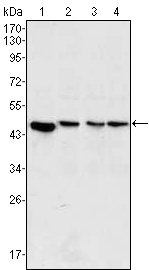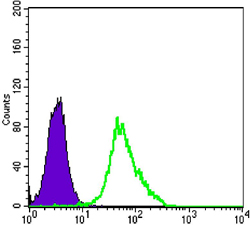MEK-2 Monoclonal Antibody
- Catalog No.:YM0435
- Applications:WB;IF;FCM;ELISA
- Reactivity:Human;Mouse;Rat
- Target:
- MEK2
- Fields:
- >>EGFR tyrosine kinase inhibitor resistance;>>Endocrine resistance;>>MAPK signaling pathway;>>ErbB signaling pathway;>>Ras signaling pathway;>>Rap1 signaling pathway;>>cGMP-PKG signaling pathway;>>cAMP signaling pathway;>>HIF-1 signaling pathway;>>FoxO signaling pathway;>>Sphingolipid signaling pathway;>>Phospholipase D signaling pathway;>>Autophagy - animal;>>mTOR signaling pathway;>>PI3K-Akt signaling pathway;>>Apoptosis;>>Cellular senescence;>>Vascular smooth muscle contraction;>>VEGF signaling pathway;>>Apelin signaling pathway;>>Gap junction;>>Signaling pathways regulating pluripotency of stem cells;>>Neutrophil extracellular trap formation;>>Toll-like receptor signaling pathway;>>Natural killer cell mediated cytotoxicity;>>T cell receptor signaling pathway;>>B cell receptor signaling pathway;>>Fc epsilon RI signaling pathway;>>Long-term potentiation;>>Neurotrophin signaling pathway;>>Long-term depression;>>Regulation of actin cytoskeleton;>>Insulin signaling pathway;>>GnRH signal
- Gene Name:
- MAP2K2
- Protein Name:
- Dual specificity mitogen-activated protein kinase kinase 2
- Human Gene Id:
- 5605
- Human Swiss Prot No:
- P36507
- Mouse Gene Id:
- 26396
- Mouse Swiss Prot No:
- Q63932
- Rat Gene Id:
- 58960
- Rat Swiss Prot No:
- P36506
- Immunogen:
- Purified recombinant fragment of human MEK-2 expressed in E. Coli.
- Specificity:
- MEK-2 Monoclonal Antibody detects endogenous levels of MEK-2 protein.
- Formulation:
- Liquid in PBS containing 50% glycerol, 0.5% BSA and 0.02% sodium azide.
- Source:
- Monoclonal, Mouse
- Dilution:
- WB 1:500 - 1:2000. IF 1:200 - 1:1000. Flow cytometry: 1:200 - 1:400. ELISA: 1:10000. Not yet tested in other applications.
- Purification:
- Affinity purification
- Storage Stability:
- -15°C to -25°C/1 year(Do not lower than -25°C)
- Other Name:
- MAP2K2;MEK2;MKK2;PRKMK2;Dual specificity mitogen-activated protein kinase kinase 2;MAP kinase kinase 2;MAPKK 2;ERK activator kinase 2;MAPK/ERK kinase 2;MEK 2
- Molecular Weight(Da):
- 44kD
- References:
- 1. Mol Cell Biol. 1993 Aug;13(8):4679-90.
2. Eur J Biochem. 1995 Nov 15;234(1):32-8.
3. Oncogene. 1998 Jul 9;17(1):57-65.
- Background:
- The protein encoded by this gene is a dual specificity protein kinase that belongs to the MAP kinase kinase family. This kinase is known to play a critical role in mitogen growth factor signal transduction. It phosphorylates and thus activates MAPK1/ERK2 and MAPK2/ERK3. The activation of this kinase itself is dependent on the Ser/Thr phosphorylation by MAP kinase kinase kinases. Mutations in this gene cause cardiofaciocutaneous syndrome (CFC syndrome), a disease characterized by heart defects, mental retardation, and distinctive facial features similar to those found in Noonan syndrome. The inhibition or degradation of this kinase is also found to be involved in the pathogenesis of Yersinia and anthrax. A pseudogene, which is located on chromosome 7, has been identified for this gene. [provided by RefSeq, Jul 2008],
- Function:
- catalytic activity:ATP + a protein = ADP + a phosphoprotein.,disease:Defects in MAP2K2 are a cause of cardiofaciocutaneous syndrome (CFC syndrome) [MIM:115150]; also known as cardio-facio-cutaneous syndrome. CFC syndrome is characterized by a distinctive facial appearance, heart defects and mental retardation. Heart defects include pulmonic stenosis, atrial septal defects and hypertrophic cardiomyopathy. Some affected individuals present with ectodermal abnormalities such as sparse, friable hair, hyperkeratotic skin lesions and a generalized ichthyosis-like condition. Typical facial features are similar to Noonan syndrome. They include high forehead with bitemporal constriction, hypoplastic supraorbital ridges, downslanting palpebral fissures, a depressed nasal bridge, and posteriorly angulated ears with prominent helices. The inheritance of CFC syndrome is autosomal dominant.,function:C
- Subcellular Location:
- Cytoplasm . Membrane ; Peripheral membrane protein . Membrane localization is probably regulated by its interaction with KSR1. .
- Expression:
- Colon carcinoma,Epithelium,Human cerebellum,Muscle,Platelet
Identification of WISP1 as a novel oncogene in glioblastoma. INTERNATIONAL JOURNAL OF ONCOLOGY Int J Oncol. 2017 Oct;51(4):1261-1270 WB Human 1:1000 U251 cell, U373-MG cell
Water‑soluble nano‑pearl powder promotes MC3T3‑E1 cell differentiation by enhancing autophagy via the MEK/ERK signaling pathway. Molecular Medicine Reports Mol Med Rep. 2018 Jul;18(1):993-1000 WB Mouse 1:1000 MC3T3-E1 cell
- June 19-2018
- WESTERN IMMUNOBLOTTING PROTOCOL
- June 19-2018
- IMMUNOHISTOCHEMISTRY-PARAFFIN PROTOCOL
- June 19-2018
- IMMUNOFLUORESCENCE PROTOCOL
- September 08-2020
- FLOW-CYTOMEYRT-PROTOCOL
- May 20-2022
- Cell-Based ELISA│解您多样本WB检测之困扰
- July 13-2018
- CELL-BASED-ELISA-PROTOCOL-FOR-ACETYL-PROTEIN
- July 13-2018
- CELL-BASED-ELISA-PROTOCOL-FOR-PHOSPHO-PROTEIN
- July 13-2018
- Antibody-FAQs
- Products Images

- Western Blot analysis using MEK-2 Monoclonal Antibody against PC-12 (1), Jurkat (2), HeLa (3) and NIH/3T3 (4) cell lysate.

- Immunofluorescence analysis of Hela cells using MEK-2 Monoclonal Antibody (green). Red: Actin filaments have been labeled with DY-554 phalloidin. Blue: DRAQ5 fluorescent DNA dye.

- Flow cytometric analysis of Hela cells using MEK-2 Monoclonal Antibody (green) and negative control (purple).



